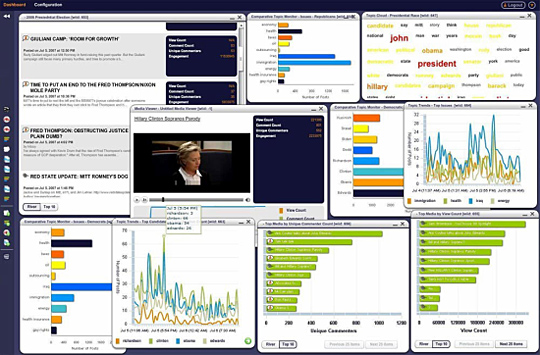Social media monitoring tools that report and trend metrics like Likes, Tweets, Comment Threads and Positive/Negative Buzz are fast growing. In fact, within just the last month, VC’s raised over $25 million to fund new companies launching social media monitoring software.
Yet, as the chart below from KISSMetrics shows, once companies buy into and start using these dashboards, only 1/3 believe they made a smart decision. 6% get so frustrated they are prepared to switch to another vendor.
It’s clear like social media, social media monitoring tools are here to stay. SocialMedia.biz compiled a thorough and extensive review of the Top 20 vendors.
But could it be the allure of all this data leaves companies, once they get them, asking: “What do I do with all this data?”
Here are 5 social media monitoring mistakes and 7 good ideas.
- SOFTWARE IS NOT A SUBSTITUTE FOR STRATEGY: A dashboard with lots of data is not a substitute for a plan of action, a clear definition of goals and how they will be achieved.
- SOCIAL MEDIA MONITORING HAS LITTLE VALUE WITHOUT INTEGRATION: Many social media monitoring tools claim to monitor the “social landscape” or report on a “social campaign.” This is a fragmented look at a brand’s presence and social metrics should be integrated with overall campaign measurements.
- SOCIAL METRICS MEASURE RELATIONSHIPS BEFORE THEY MEASURE SALES: Likes, Tweets, Posts and Comments have value because they measure our relationship with brands. This determine our behaviors and actions that lead to sales. Measurement tools have value when they correlations between these areas.
- SOCIAL MEDIA MONITORING TOOLS GIVE US DATA BUT PEOPLE GIVE US INSIGHTS: The best data in the world still requires people to uncover the insights. Without it, social media monitoring tools risk being a sophisticated compilation of charts and graphs.
- MORE DATA RARELY LEADS TO BETTER ANALYSIS: Lots of data is always hard to decipher. But, when we dig deeper into a specific piece of data and look for the key segments, it usually gives valuable insights.
- DEFINE BUSINESS GOALS: Begin with the end in mind; review goals early and often
- KNOW THE 10%/90% RULE: In Web Analytics; An Hour a Day, Avinash Kaushik describes the 10%/90% rule; that is, for every $10 invested in analytic software, $90 is required for an intelligent analyst. Bottom line: It’s the people, not the software, that determine social monitoring success.
- REMEMBER THE “OLD” TOOLS AS WELL AS THE “NEW”: The Google products, Google Alerts, Google Trends and, of course, Google Analytics, are still some of the best social media monitoring tools around. For example, on this website, Google Analytics’ Traffic Referrals tells us 50% of traffic comes from search, 24% is direct and 26% is from social efforts. Of that, Twitter is the #1 referrer but people who come from Twitter spend only 41 seconds on the site. By contrast, LinkedIn is #2 and a weekly Email is #3 (you can sign up in the upper right). Readers from these sources spend 4:40 and 7:20, respectively, on site. Twitter has value for outreach but our clients tend to come from LinkedIn and Email Marketing.
- EMPOWER THE DASHBOARD THROUGH INTEGRATION: Don’t just have social metrics on your dashboard; integrate brand metrics like leads, conversion and sales so your dashboard tells the full story.
- UNDERSTAND THE DIFFERENCE BETWEEN HIGH-VALUE AND HIGH MAINTENANCE: Every business has a range from best to worst consumers. Use your social media metrics to establish segments (e.g. time spend on site, # of posts, depth of engagement) of who to spend time with and who you shouldn’t.
- IDENTIFY THE HANDFUL OF KEY METRICS ON WHICH YOU ARE PREPARED TO TAKE ACTION: Look at as many measurement as you want, but identify and hold your brand accountable to the few that are critical to effective business performance; review regularly (e.g. monthly, quarterly) are be prepared to take action on the results.
- CREATE AN ACTIONABLE SCORECARD: These handful of metrics should be charted; goals should be established and progress should be measured against goals as well as a relevant prior period. There are your KPI’s (Key Performance Indicators), the actionable scorecare for keeping your strategy on track.
For the complete findings on the KISSMetrics study on social media monitoring tools, below is an infographic from Visaul.ly.
Do you agree with these mistakes companies make when they buy social media monitoring tools? Have we given you good ideas?








Good stuff. I find it amazing how much of an expert you have become. I remember our first recruiter/candidate meeting years ago, and the thing that struck me the most about you was your ability to continually reposition yourself and learn new things and areas of expertise to keep you viable in the professional arena. Good for you!
Thank you Peter. Likewise, I’ve always placed high-value on your advice and counsel over the years. Appreciate your comment.
[…] what social media is doing for you? Well, Rob Petersen at BarnRaisers looks at 5 social media monitoring mistakes and 7 good ideas to help you understand how customers are talking about you and what you can do about […]
Love the infographic, makes some good points. Can you suggest a monitoring tool for a small business? I keep hearing Blurtster, but I can’t find any reviews of it. Have you heard of it?
[…] See on barnraisersllc.com […]